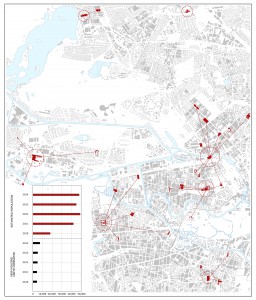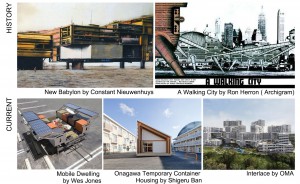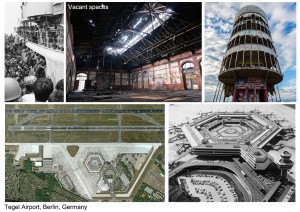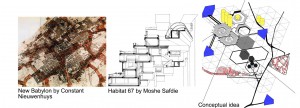|
|
  This thesis explores a new refugee housing typology, an improved design and planning methodology of temporary transitional settlement in regards to the Syrian Refugee Crisis 2015. It aims to investigate the concept of organic metabolism, using modular system to enable gradual growth or future expansion in order to deal with housing shortage. In addition, creating an integration of basic living condition for collective life experience and additional plug in shared communal facilities in order to generate a new form of decent refugee living, forming an instant community. Ideally, to blur the uncertainties and also This thesis explores a new refugee housing typology, an improved design and planning methodology of temporary transitional settlement in regards to the Syrian Refugee Crisis 2015. It aims to investigate the concept of organic metabolism, using modular system to enable gradual growth or future expansion in order to deal with housing shortage. In addition, creating an integration of basic living condition for collective life experience and additional plug in shared communal facilities in order to generate a new form of decent refugee living, forming an instant community. Ideally, to blur the uncertainties and also  both tangible and intangible borders or boundaries between different cultures. both tangible and intangible borders or boundaries between different cultures.

HISTORY
Back in the 1950s, with the rise in theoretical concern of urbanism towards an utopia, the New Babylon theory by Constant Nieuwenhuys promotes a future utopian city that collects alternative life experiences. All these collective basic utilities can be linked and formed a transformable megastructure in order to generate social spatiality. Similarly, in the early 1960s, Archigram’s utopian proposals advocate an experimental idea on Machine Architecture. The group experimented with modular technology, mobility through environment and space capsules.
CURRENT
The disaster relief projects of Shigeru Ban offer immediate response through the use of sustainable material in order to reconstruct an instant interactive community in short period of time. Whereas, the Mobile Dwelling by Wes Jones is a more high- technological, self- sufficient device that reinforces the concept of Machine Architecture. On the other hand, the utopian(futuristic) idea of collective life experience is further expanded through an interconnected approach to new residential typology with multiple communal spots in The Interlace, a residential complex in Singapore by OMA.
THESIS PURPOSE
My thesis aims to explore a new housing typology, an improved design and planning methodology of transitional settlement for refugee. Rather than a development of “tent city”, I would like to investigate the concept of organic metabolism, using modular system to enable growth in order to deal with the housing shortage problem. The proposal will include an integration of basic living condition for collective life experiences and additional plug in shared communal facilities, that ideally to generate a new form of decent refugee living complex.

SCOPE
“Temporary architecture can range from one- time educational event to a month- long art installation to mobile architecture that is designed to be portable but at the same time, it may stay on one site for years.” ( Dann et al.2009,3) With the constantly changing of national structures, resulting in wars, conflicts, bombing and so on, permanent architecture massive as in city scale can become temporary.These factual issues blur the original definition of temporary and permanent architecture. Therefore, this thesis is designed for temporary fuctions within, it can be diversed that shifting programs through time, suggesting a high level of flexibility and mobility.
SELECTION OF SITE
Berlin Tegel Airport, where locates in north west of Berlin city centre. The main terminal building is hexagonal- shaped with an inner open square for vehicle drop off. The boarding gates are allocated outside the hexagonal rim which all programs are efficiently decentralized. However, the airport is scheduled to be closed due to the completion of the new city airport. Therefore, by adapting reuse this left over land, the existing main hexagonal structure contains great potential for an architectural metabolism, a strong sense of infinite practicality which suggests future expansion if needed. Moreover, the idea of decentralization can also be adapted by inserting different plug- in shared facilities in order to generate a new form of collective community through density, functionality and flexibility in responses to the instant rise in population.

Step 1 – Analytical Research A series of demographic datas will be carried out, such as development of population and influx of immigration, under a timeline in order to draw a future scenario or trend. Furthermore, mapping of the current refugee movement and related facilities provided by the local government in a broader scale to understand the requirement and location for the new intervention.
Step 2 – Preliminary Design( due Review 01 ) To develop the idea of collective life styles, a series of conceptual diagrams and models will be conducted to explore the diversity and possibilities for shared or communal facilities and that can be explored in modular system.
Step 3 – Development of Design ( due Review 02 ) Master plan will be represented in drawings and physical models ( Scale 1:500 ) in order to show the overall massing. Plan and sectional drawings will be conducted to illustrate connectivity and sufficient circulation system with the German context.
Step 4 – Revisions / Refinements ( due Review 03 ) Further zoom into the design via detailed drawings, renderings and sectional models (Scale 1:75 or 1:100 ). Final refinement will be made based on the feedback in Review 02.
BIBLIOGRAPHY
Theory reference:
– NIEUWENHUYS, Constant, “New Babylon – A Nomadic City”, written for the exhibition catalogue published by the Haags Gemeetenmuseum at Hague, 1974.
– KOOLHAAS & OBRIST,Project Japan: Metabolism Talks…,Consortium Book Sales & Dist, 2011 – ROSSI, Aldo, The Architecture of the City, The MIT Press, 1966
– ROWE, Colin and KOETTER, Fred, The Collage City, The MIT Press,1984
Technical reference:
– Shigeru Ban, Humanitarian Architecture, Distributed Art Publishers, 2014
– Operative Design: A Catalog of Spatial Verbs, 2012
– Modular Pre-Fab Housing: A Scientific Approach by Nick Marinos, 2011
Project reference:
– New Babylon by Constant Nieuwenhuy
– The Walking City by Ron Herron, Archigram
– Onagawa Temporary Container Housing by Shigeru Ban
– Mobile Dwelling by Wes Jones – Interlace by OMA – Habitat 67 by Moshe Safdie
|